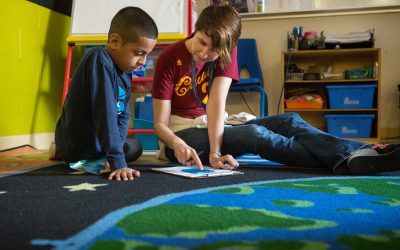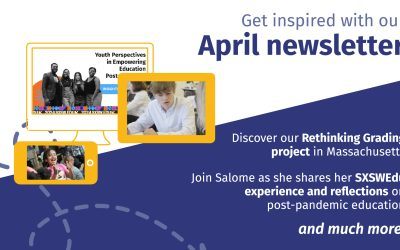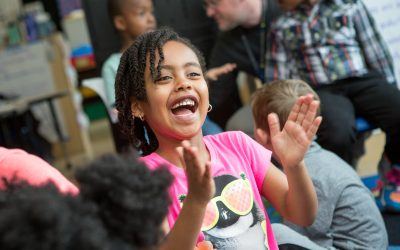
by Jon Altbergs and Laurie Gagnon
At reDesign, we encourage the adoption of a Learning Cycle that guides the learner through the habits and skills that support the development of competency with practice over time. In this post, we dig into the synthesis and reflection element of the learning cycle.
Let’s take a moment to revisit the two dimensions of the learning cycle. It represents the stages of meaningful learning that occur simultaneously during daily learning experiences (the “inner circle), and across multi-week units of study they constitute (the “outer circle”) that build toward authentic, competency-building work.
.

As our colleague Sydney Schaef explained in A Friendly Introduction to the Competency-based Learning Cycle,
In a nutshell, the Competency-based Learning Cycle is a visual framework that illustrates the cognitive and metacognitive processes that help learners develop competency with practice and feedback, as they work and learn in increasingly challenging contexts.
…The “outer circle” represents the four major stages of a competency-based project or unit of study through which learners explore a compelling question or issue.
…The “inner circle” structures daily learning experiences. … These learning experiences are purposefully and directly connected to the larger arc (outer circle), such that successful, recursive movement through this inner cycle enables progress through the four stages of the unit.
Ongoing synthesis and reflection anchor the learning cycle. Every learning experience, we believe, should culminate with synthesis and reflection questions. Why are synthesis and reflection questions so important to close the loop of a lesson or learning experience? They are essential because the information they provide:
- supports the provision of individualized feedback
- builds relationships through teacher attunement
- gauges student engagement
- offers insight into learners’ metacognition, the key to self-directed learning.
Ultimately, synthesis and reflection questions are a moment of pause to “lift the hood” on learners’ thinking.
Meaningful learning and assessment generate evidence of learning (as opposed to simply evidence of working). Synthesis and reflection help the learner situate new ideas into their overall understanding and helps the teacher gain insight into the thinking processes and conceptual understanding behind other work that the learner produces. When planning lessons, teachers often rightfully focus on designing assignments and activities that prompt students to think critically about the content they are learning. But rigorous assignments are not enough. Students need opportunities to synthesize and reflect on their learning. Synthesis connects the day’s learning to prior learning, helping students build schema and deepen their understanding. Reflection encourages metacognitive development by shifting the focus from the what of learning to the how.
A synthesis prompt asks students to identify the important learning, summarize the learning, and articulate connections between the new learning and prior learning, knowledge, or experience in order to create or deepen understanding. Well-crafted synthesis questions lay the foundation for transferability of skills and knowledge. By incorporating synthesis into daily practice, building the connections that expand schema and ensure transferability is an ongoing process, rather than one that occurs at the end of a unit, the end of the year, or when new material is introduced.
Synthesizing, like other strategies and skills, is a capability that develops over time and should be explicitly taught. Responding to a synthesis prompt calls upon three specific elements: determining importance, summarizing, and connecting. First, students identify the important parts of their learning, the key takeaways from the lesson or learning experience that were essential to completing the task at hand. Second, students summarize by concisely communicating the what and the why of their learning—the key content and its importance. Finally, when students synthesize they connect the day’s learning to a larger context, such as prior learning, the essential question, or their own experience and describe how connecting the two deepens their understanding. Connections can also be made to novel situations to extend thinking.
Ultimately, the purpose of synthesis questions is the production, rather than reproduction, of knowledge. When students begin to explore a specific topic, their pool of knowledge may be limited, making rich connections and synthesis more difficult, but as they have more to call upon, those new (to them) insights happen more often.
Though the thinking underlying synthesis prompts is complex, the prompts themselves don’t have to be. I used to think … but then I learned … and so now is a simple frame for synthesis. As part of an exit ticket, journaling prompt, or classroom discussion, this frame incorporates all three elements and creates the opportunity to uncover what students know and what gaps and misconceptions need to be addressed.
A reflection prompt asks students to look critically at their learning process from its inception to its completion. Reflection incorporates summarizing, evaluating, and inferring. When reflecting, students describe the steps they took to complete a task, focusing on their strategic action—the strategies and skills they used and the adjustments they made on their way toward their learning goal. They then make inferences about the influence of their actions on their outcomes to evaluate the effectiveness of those actions. Reflection is vital to fostering agency, self-efficacy, and independence, as it aids in building self-regulated learning skills: the ability to set goals and appraise tasks; monitor one’s learning progress; apply strategies as needed; and sustain motivation.
Reflection helps the learner to evaluate whether their approach to their learning was successful and to surface lessons about how they learn, which can help them in being successful in their next learning endeavor.
- What was my learning goal? Did I achieve my learning goal?
- How did I learn what I learned?
- What worked well as I learned? How do I know it worked well? What did not work as well as I wanted? How do I know it didn’t work well?
- What changes did I make on the fly? What was the effect of those changes?
- What did I learn about myself as a learner? How will this insight help me learn in the future?
- How did my thinking change as a result of my new learning?
- How can I use my new learning in the future?
If you are new to the idea of synthesis and reflection as a regular part of the learning process or if you want to bring more intention to how you craft questions, check out this self-assessment checklist for Synthesis & Reflection Prompt Design. To see it in action, check out this personal narrative unit outline that illustrates how the reflection and synthesis prompts at each key stage of the unit build in complexity as learners move through the stages of the learning cycle: making meaning, investigating, creating, and finally, presenting, celebrating, and reflecting.
Back in the spring, our first tip for meaningful learning in COVID was to FOCUS ON EVIDENCE OF LEARNING (not evidence of working). Reflecting back, focusing on evidence of learning is actually a fundamental practice for learning. Now that schools and districts are getting back to school after the emergency learning situation of the spring, but still in very different conditions than before, we have the opportunity to design learning experiences that better incorporate key ideas from the research on how we learn.
If you’re interested in hands-on learning and support to help you design learning experiences that are research-based and built around the learning cycle, check out this upcoming workshop series, The Learning Cycle Workshop, offered through reDesign’s Institute in October/November. We hope to see you there!
Join the community!
Sign up to receive our newsletter, access best-of educational resources, and stay in the know on upcoming events and learning opportunities. We hope to see you soon!



